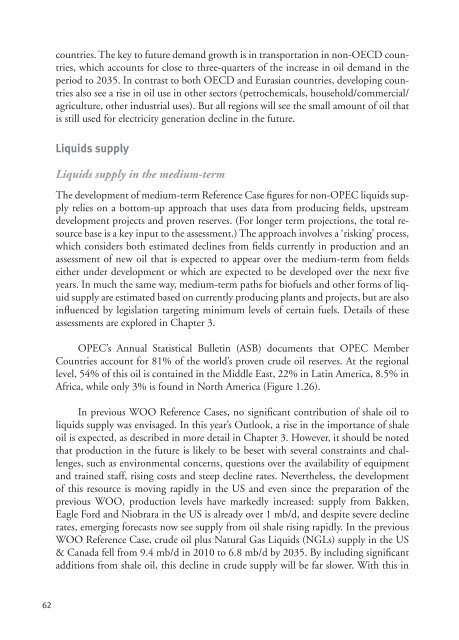World Oil Outlook - Opec
World Oil Outlook - Opec
World Oil Outlook - Opec
- TAGS
- world
- outlook
- opec
- www.opec.org
You also want an ePaper? Increase the reach of your titles
YUMPU automatically turns print PDFs into web optimized ePapers that Google loves.
62<br />
countries. The key to future demand growth is in transportation in non-OECD countries,<br />
which accounts for close to three-quarters of the increase in oil demand in the<br />
period to 2035. In contrast to both OECD and Eurasian countries, developing countries<br />
also see a rise in oil use in other sectors (petrochemicals, household/commercial/<br />
agriculture, other industrial uses). But all regions will see the small amount of oil that<br />
is still used for electricity generation decline in the future.<br />
Liquids supply<br />
Liquids supply in the medium-term<br />
The development of medium-term Reference Case figures for non-OPEC liquids supply<br />
relies on a bottom-up approach that uses data from producing fields, upstream<br />
development projects and proven reserves. (For longer term projections, the total resource<br />
base is a key input to the assessment.) The approach involves a ‘risking’ process,<br />
which considers both estimated declines from fields currently in production and an<br />
assessment of new oil that is expected to appear over the medium-term from fields<br />
either under development or which are expected to be developed over the next five<br />
years. In much the same way, medium-term paths for biofuels and other forms of liquid<br />
supply are estimated based on currently producing plants and projects, but are also<br />
influenced by legislation targeting minimum levels of certain fuels. Details of these<br />
assessments are explored in Chapter 3.<br />
OPEC’s Annual Statistical Bulletin (ASB) documents that OPEC Member<br />
Countries account for 81% of the world’s proven crude oil reserves. At the regional<br />
level, 54% of this oil is contained in the Middle East, 22% in Latin America, 8.5% in<br />
Africa, while only 3% is found in North America (Figure 1.26).<br />
In previous WOO Reference Cases, no significant contribution of shale oil to<br />
liquids supply was envisaged. In this year’s <strong>Outlook</strong>, a rise in the importance of shale<br />
oil is expected, as described in more detail in Chapter 3. However, it should be noted<br />
that production in the future is likely to be beset with several constraints and challenges,<br />
such as environmental concerns, questions over the availability of equipment<br />
and trained staff, rising costs and steep decline rates. Nevertheless, the development<br />
of this resource is moving rapidly in the US and even since the preparation of the<br />
previous WOO, production levels have markedly increased: supply from Bakken,<br />
Eagle Ford and Niobrara in the US is already over 1 mb/d, and despite severe decline<br />
rates, emerging forecasts now see supply from oil shale rising rapidly. In the previous<br />
WOO Reference Case, crude oil plus Natural Gas Liquids (NGLs) supply in the US<br />
& Canada fell from 9.4 mb/d in 2010 to 6.8 mb/d by 2035. By including significant<br />
additions from shale oil, this decline in crude supply will be far slower. With this in
















